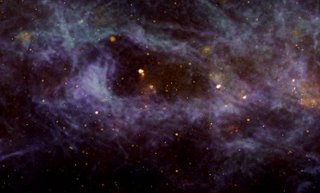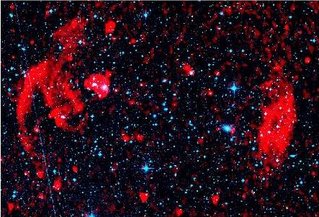Cosmic Bubble

_______________________________________________________
Image courtesy of NRAO/AUI and Jayanne English (U. Manitoba)
& Jeroen Stil, supported by Russ Taylor (U. Calgary); NRAO/AUI & MSX
A Majestic Gas Shell Revealed by the VLA.
ENLARGE Image
What appears to be the hole of an elongated smoke ring in this National Radio Astronomy Observatory image really is an enormous, nearly empty, bubble blown into the dusty, gas disk of our Milky Way Galaxy.
Such interstellar bubbles are sculpted by the force of the wind and radiation from typically a few dozen hot, massive stars along with the explosive impact of dying stars which are called supernovae. The force sweeps up the disk's gas that is in its path, creating a gas shell surrounding a bubble.
The neighbourhood of our own solar system resides in such a cavity. However the shell in this image, catalogued (using its coordinates) as galactic shell GS 62.1+0.2-18, is located at a distance of 30,000 light years from Earth, and measures 1,100 by 520 light years. Despite its distance, this "smoke ring" appears so large on the sky that the apparent width of the full moon would fit eight times inside it.
The bright yellowish-orange dots scattered across this image are clusters of young, massive stars surrounded by hot gas and are called nebulae. Astronomers from the International/VLA Galactic Plane Survey have determined that none of these clusters harbor the stars that blew the giant shell since none of the clusters are at the same distance as the shell.
Indeed they all are located closer to the Earth than the shell is.
Probably, the stars that blew GS 62.1+0.2-18's hole perished as supernova explosions. This image shows only a small part of a survey which uses both the Very Large Array and the Green Bank Telescopes to trace, in detail, the cool gas in our Galaxy. This gas has been coloured purple, blue and green in this image.
In order to show the locations of star clusters, the image of gas was overlaid with 2 additional images. The one of radio emission associated with regions of hot gas was coloured orange, while heated dust, imaged in infrared by the Midcourse Space Experiment satellite, was coloured red.
Cosmic Bubble Image Wins NRAO Contest
This study is published by VGPS investigators in the Astronomical Journal,
Volume 132, number 3, page 1158.
Investigator(s): J. M. Stil, A. R. Taylor, J. M. Dickey, D. W. Kavars, P. G. Martin, T. A. Rothwell, A. I. Boothroyd, Felix J. Lockman, and N. M. McClure-Griffiths
_______________________________________________________

VLA Discovers
Giant Rings
Around
Galaxy Cluster
Astronomers using the National Science Foundation's Very Large Array (VLA) radio telescope have discovered giant, ring-like structures around a cluster of galaxies. The discovery provides tantalizing new information about how such galaxy clusters are assembled, about magnetic fields in the vast spaces between galaxy clusters, and possibly about the origin of cosmic rays.
These giant, radio-emitting rings probably are the result of shock waves caused by violent collisions of smaller groups of galaxies within the cluster
The newly-discovered ring segments, some 6 million light-years across, surround a galaxy cluster called Abell 3376, more than 600 million light-years from Earth. They were revealed because fast-moving electrons emitted radio waves as they spiraled around magnetic field lines in intergalactic space.
Read more NRAO Ring Cluster release 03 Nov 2006
_______________________________________________________
Understanding the Tonal by Plato
Bursting bubbles of new universes by Plato
Super-supermassive Black-hole from Universe Today
_______________________________________________________
_______________________________________________________
Almost famous Quote: “It’s certainly true that we don’t yet know whether the universe is eternal or whether it had a beginning, and we certainly don’t understand the details of its origin.” “The truth is, we just don’t know. I’m guessing eternal, but we just don’t know.”
Sean Carroll @ Cosmic Variance
_______________________________________________________
Famous Quotes
Always remember that you are absolutely unique.
Just like everyone else. Margaret Mead
_______________________________________________________


<< Home